
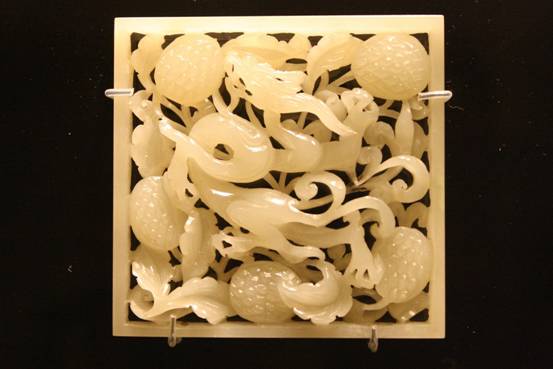 |
|
Jade belt plaque, Ming Dynasty (14th-17th centuries). [Photo/pointurier.org] |
The jade used since ancient times in China is nephrite, which in its pure state is white but may be green, cream, yellow, brown, gray, black or mottled due to the presence of impurities, chiefly iron compounds. Chinese used the generic term yu (jade) to cover a variety of related jade-like stones, including nephrite, bowenite (a type of serpentine) and jadeite.
Xu Shen, from the Han Dynasty (206BC-221AD) details five virtues of jade in his work Shuowenjiezi (Discussions of Writings and Explanations of Character) - benevolence, for its luster and brilliance; honesty, for its translucent texture; wisdom, for its tranquil and far-reaching tone; integrity and bravery, for it may be broken but cannot be twisted.
Jade has always been the material most highly prized by Chinese, above silver and gold. In ancient times, jade was usually placed with dead emperors or nobles in tombs or enshrined in rituals. For centuries, this extremely tough translucent stone has been associated with royalty and regarded as a token of divinity.
Why do the Chinese hold jade in such esteem? Through the following nine tales, from myth and historical records, you may get a glimpse of Chinese people’s reverence for jade.
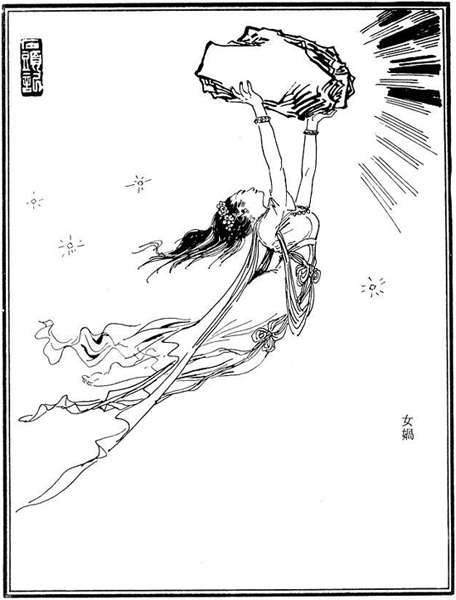 |
|
An illustration of Nüwa mending the sky with a five-colored stone. [Photo/Xinhua.com] |
Nü wa Bu Tian/ Nüwa mends the sky
Nüwa is an ancient goddess in Chinese mythology best known for creating mankind and repairing the pillar of heaven. In Huainanzi, a Chinese philosophical classic completed around 2 BCE, the four pillars supporting heaven were broken, a fire blazed and a flood plagued human beings. Nüwa smelted a five-colored stone to patch up the sky and saved numerous lives. Then, she scattered the remainder of the stone on the earth, which turned into all kinds of jade. The five-colored stone symbolizes the five basic elements composing life: wood, fire, earth, metal and water.
Inspired by the tale of the five-colored-stone, legendary stories have been created in Chinese literature. In A Dream of Red Mansions by Cao Xueqin, the hero Jia Baoyu was an incarnation of a piece of the magical five-colored stone left by Nüwa, who developed human emotions and descended to earth to experience human life. He was named Baoyu, literally priceless jade, because he was born with a beautiful jade in his mouth. In Journey to the West, the leading character Monkey King was depicted as a creation out of a stone from a holy mountain and possessed unearthly powers at birth.
Nüwa is believed to be the ancestry of Chinese people. In Chinese mythology, human beings were nearly extinct after severe natural catastrophes. Nüwa and her brother Fuxi were the only two left on earth, to maintain reproduction, she married Fuxi and gave birth to the earliest Chinese.
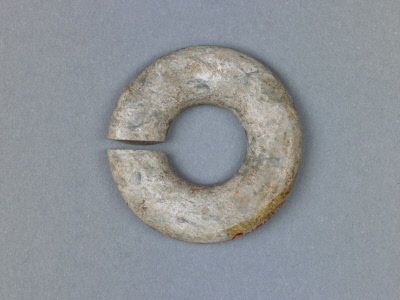 |
|
A jade jue from the Neolithic Age, housed in the Palace Museum. [Photo/dpm.org.cn] |
Xi Wangmu presents jade to the Emperors Yao and Shun
In Chinese folklore, Xi Wangmu, literally meaning Queen Mother of the West, is a goddess known from ancient times, who resided in her palace on the mythological Mount Kunlun in the Himalayas where ancient human ancestors originated. It is believed that Xi Wangmu could bring the dead back to life with elixir and the orchard in her garden grew peaches which ripened once every thousand years giving longevity to a person who ate them.
In literature or Chinese Opera, Xi Wangmu is depicted as a serious and august goddess who took charge of heaven and all the deities. The most well-known story of Xi Wangmu is from Journey to the West, a novel by Wu Cheng’en during the Ming Dynasty, telling about the Monkey King who stole her magical peaches which were to be feasted on at a banquet.
The earliest official narrative of Xi Wangmu can be found in Shangshu, a classic record of China’s ancient history, in which she met with legendary rulers of ancient China including the Yellow Emperor, Emperors Yao and Shun and the King of the Zhou Dynasty and presented them with maps and delicately carved jade. In today’s research, historians tend to regard Xi Wangmu as a title of the ruler of clan tribes in the western part of China.
In historical records, the jade Xi Wangmu presented to Emperor Yao was a kind of ritual jade named jue, which is a pendant in the shape of a slit ring with a hole in the center.
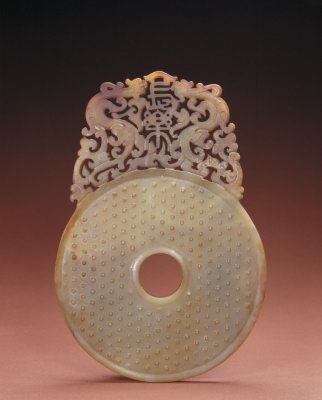 |
|
A jade bi-disk with characters for "Eternal Happiness" carved in openwork from the Eastern Han (25-220), housed in the Palace Museum. [Photo/dpm.org.cn] |
He Shi Bi
He Shi Bi is a piece of jade stone found in the State of Chu during the Zhou Dynasty by a man named Bian He. He recognized the value of the jade and offered it to King Li. The King had his jeweler examine it who said it was mere stone and the king punished He by having his left foot cut off. Years later He offered the stone to King Wu, successor of the throne, but had his right foot cut off for the same reason. He held his jade stone and cried for three days and three nights, accusing the king of mistaking an honest man for a liar. Hearing this, the new King Wen had his jeweler cut open the stone and a large pure jade was revealed. King Wen named the jade He Shi in honor of Bian He’s integrity.
Bi is a carved jade ornament shaped like a disc with a hole in its center, they have been found placed with dead bodies in tombs.
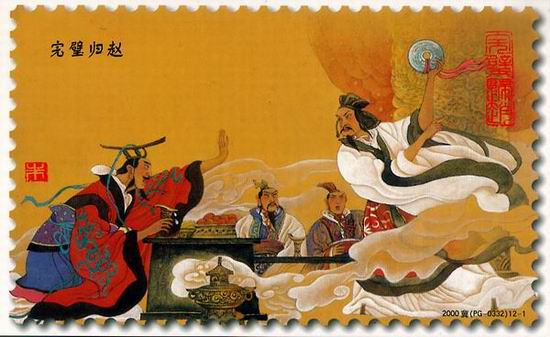 |
|
Illustration of the story Return the Jade Intact to the State of Zhao. [Photo/sina.com.cn] |
Wan Bi Gui Zhao/Return the Jade Intact to the State of Zhao
Derived from Biographies of Lian Po and Lin Xiangru in Historical Records, this phrase means to return something intact to its owner.
During the late warring states period, He Shi Bi was given to the state of Zhao as a betrothal present by the state of Chu, while the king of the Qin State was longing for this priceless treasure and offered 15 fortresses in exchange. For fear of Qin’s military power, the king of Zhao assigned Lin Xiangru, a bright minister, to negotiate with Qin over He Shi Bi. He soon found that the king of the Qin State wanted to intentionally swindle the jade rather than give a fortress in exchange. Lin Xiangru, relying on great wisdom and courage, managed to leave Qin and return the precious jade intact to Zhao.
It is said that after Qin conquered all the other warring states and united China in 221 BC, He Shi Bi was made into the Imperial Seal of China by Qin Shi Huang and became an emblem of the emperor’s supreme power.
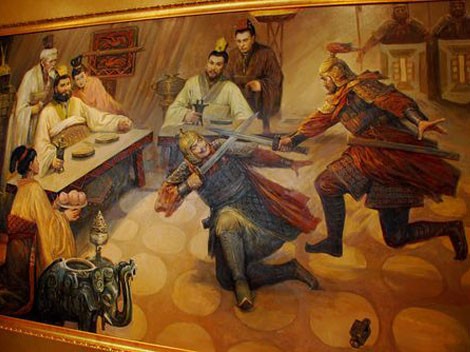 |
|
Painting of the story Hong Men Yan.[photo/cultural-china.com] |
Hong Men Yan/Hongmen Banquet
Jade plays an important part in the history of ancient China, in the story of Hong Men Yan, the jade witnessed the failure of a political conspiracy and a prelude to the rise of a new dynasty.In 206 BC, Xiang Yu and Liu Bang were two prominent leaders who rebelled against the Qin Dynasty. Only one could win supremacy over China and ascend the throne. Fan Zeng, counselor of Xiang Yu, invited Liu Bang to a banquet at Hong Men, scheming to kill him. During the banquet, Fan Zeng made signals with his jade pendant and hinted many times to Xiang Yu to kill Liu Bang, but Xiang ignored him.
Fan had to call for an assassin named Xiang Zhuang to stab Liu Bang while pretending to perform a sword dance. Liu Bang managed to escape from the banquet and later cornered Xiang Yu by the River Wujiang. Xiang Yu committed suicide after his defeat and Liu Bang established the Han Dynasty and became its first emperor.
 |
|
Yu Lian Huan is a jade ornament composed of two inseparable rings. [Photo/shangdu.com] |
Yu Lian Huan/Chinese Rings
In Zhan Guo Ce, or Strategies of the Warring States, a tale goes that the king of Qin sent a messenger with a chain of two rings of jade to the state of Qi, attempting to test whether the king of Qi dared to battle with Qin, the most powerful state in the warring period of ancient China. Since the two rings were forged together, it was impossible to disentangle them. However the queen of Qi had her attendant smashed the rings with a hammer, and replied to the messenger that Qi had solved the puzzle according to Qin’s command. Hearing this, the king of Qin put off his plan to invade Qi, for he feared of Qi people’s resolution to defend their own country.
The Chinese have always paid homage to a tough person who never gives up or loses their grace under great pressure, who has much resemblance to the characters in the writings of Ernest Hemingway. One proverb goes Ning We Yu Sui, Bu Wei Wa Quan, meaning that a person would rather die than yield to powers.
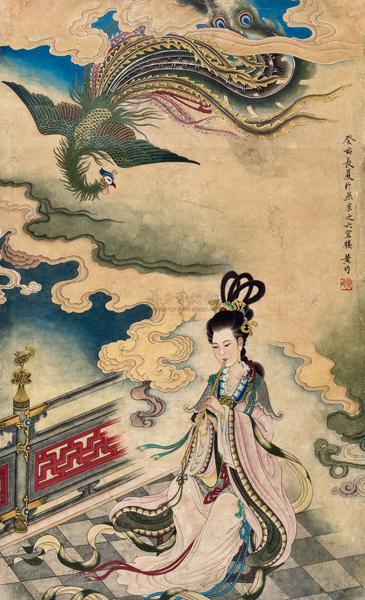 |
|
A painting of Nong Yu Chui Xiao by painter Huang Jun. [126.net] |
Nong Yu Chui Xiao/An ideal marriage
Nong Yu was a beauty in ancient Chinese myth, who was said to be the daughter of King Mu of the state of Qin in the warring period. At her birth, the king received lots of gifts, while among all the priceless treasure the girl was obsessed by a piece of green jade and could not take her hands off it. Thus the king named the girl Nong Yu, meaning playing with jade.
Nong Yu then grew into a fair lady and was extremely good at playing Xiao, a Chinese vertical end-blown flute. She taught herself to play the instrument and the tune was as clear as the warble of a phoenix. Her father had the craftsman make the jade into the flute and established a building named Feng Lou, literally meaning residence of a phoenix.
In Chinese myth, a dragon is the best company for a phoenix. The Chinese proverb Cheng Long Kuai Xu originated from the story of Nong Yu, meaning a good husband to a fair girl is like a dragon to a phoenix.
 |
|
Yuhua Stones. [Photo/163.com] |
Yu Hua Shi/Yuhua Stone
Yu Hua Shi, or Yuhua stone is a special kind of stone found only in Nanjing, China, due to the unique geology of the area. Yuhua stones are known for their bright colors and smooth surface due to being polished by the flow of the Yangtze River.
It is said that in the Liang Dynasty (502-557), a monk named Yun Guang gave a sermon on a hill near the city gate. Even the rocks nodded in approval during his speech and flower petals fell like rain. Since then, people found many pebbles with beautiful patterns and colors and called them Yuhua stone, meaning stones embedded with beautiful colors of flowers and lines like rain drops.
 |
|
File Photo |
Tears of the Water Faerie
The origins of precious minerals such as jade, agate or pearl have different versions in Chinese lore. It was said that pearls were tears of the water faeries that lived in the ocean beyond the South China Sea. They were able to breathe in the water like fish and could weave a kind of silk which was as thin as human hair. When they cried their tears would turn into beautiful pearls.
The shape of the pearls accords with the waxing and waning of the moon. Li Shangyin, poet of the Tang Dynasty, wrote this tale into his poem Jin Se. In some foreign myths pearls are dewdrops or rain drops into shells when they ascend to the surface of the sea.

Presented by Chinadaily.com.cn Registration Number: 10023870-7
Copyright © Ministry of Culture, P.R.China. All rights reserved